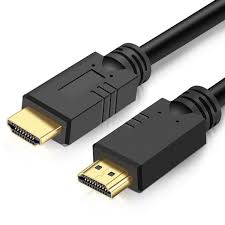HDMI – High-Definition Multimedia Interface
An interface used to transfer high definition video and audio over a single cable.
The most commonly used interface cable for TVs, DVD players, gaming machines and becoming the standard on most laptops and PCs.
Advantages of HDMI
- Higher Quality: HDMI enables loss-less transmission and better-quality video at low brightness scenes at higher resolutions.
- Intelligence: Two-way communications between video sources are enabled by HDMI Interface, which enables automatic configuration (between 480p or 720p, 16:9 or 4:3 for example)
- Deep Colours: HDMI supports 10-bit, 12-bit and 16-bit (RGB or YCbCr) colour depths
- No Compression: Since HD signals are not compressed while transmission, there is no de-gradation in signal quality
- Encryption: Devices are authorised to receive the content sent by the HDMI enabled sources. They ensure people cannot access content for piracy
- Single Cable Solution: Just one cable carries audio and visual, meaning less integration issues
- DVI compatible: HDMI is backward compatible with DVI meaning DVI enabled devices can send HD content to displays
- DisplayPort compatible: Parallel technology so compatible with each other.
- Multiple video and audio formats: A wide array of compatability
Disadvantages of HDMI
- Signal Limitations: Although cable length for HDMI varies, it is still not recommended to use a cable more than 50m in length as this could result in loss of signal.
- Blank screen syndrome: Authentication delays can lead to blank or flashing screens
- More expensive: cost per meter is more expensive than analog alternatives

HDMI interface
Commonly found in laptops and desktop computers